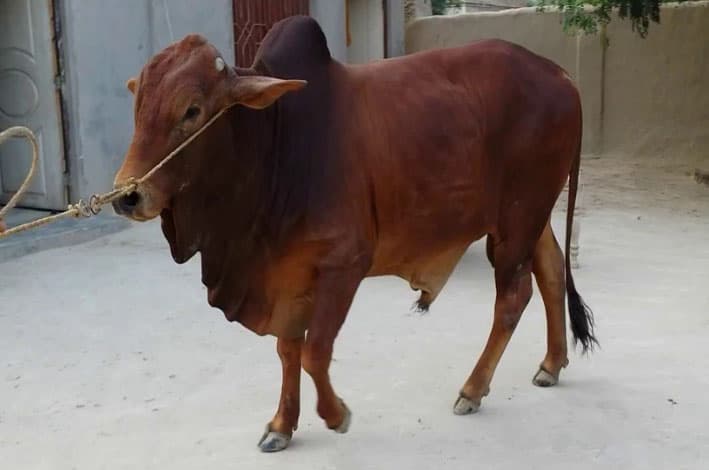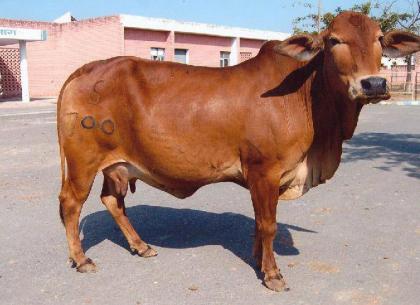
Sahiwal
Origin and Distribution
Sahiwal breed cattle are primarily reared for milk production. Its origin can be traced in the central and southern parts of Pakistan-Punjab, mainly in the districts of Montgomery (now called Sahiwal) and Okara. In India, Sahiwal can be found in districts of Rohtak, Karnal, Hisar, Gurgaon in Haryana state, Union Territory of Delhi and in West Uttar Pradesh. This area is characterized by a subtropical and arid climate. There are although their numbers have dwindled considerably. There are no authentic records available to explain how in the early days this breed developed. It is believed that it is a mixture of strains of diverse breeds that migrated from the south of India, north of Pakistan and the adjoining territory of Afghanistan. There is an apparent similarity with the Gir breed hence it is considered as a parental breed of Sahiwal cattle.

Sahiwal cow – (Image courtesy www.icar.org)
In India Sahiwal, breeding herds are mostly restricted to various institutions and military farms in the northern parts of the country. The best-known being at the National Dairy Research Institute at Karnal. A cooperative progeny testing program was established in 1982/83 between 9 institutional herds. These farms have around 900 cows and according to the plan 6–8 young bulls in each set are progeny tested of which one or two will be selected. In north India Sahiwal-HF crosses (Also called Frieswal) have been found to have improved productivity and fertility.
Characters
Sahiwal cattle are long, fleshy and heavy with the symmetrical body and loose skin when compared with Red Sindhi which it closely resembles. The mature weight of cows is around 340–400 kg and of bulls up to 700 kg. They are colored reddish Dunn or pale red, sometimes flashed with white patches. Muzzle and eyelashes are light in color. The skin color ranges from reddish-brown through to more predominant red, with varying amounts of white on the neck, and the underline. In males, color darkens towards extremities, such as head, legs, and tail. The bulls have a large, massive hump that frequently falls to one side. The height at withers is around 136 whereas the female height averages 120 cm. These animals have small heads with long, narrow faces from which emerge short and somewhat horizontal horns, which grow longer and curve upwards and inwards in bullocks. In cows, horns are very short, thick and loose. Legs are sturdy and long with well-shaped hooves. The tail is thin and short. In cows, the udder is well developed with prominent teats. Compared to other Zebu breed cows these have comparatively smooth milk let down even when calves are weaned very early. This is because of selection over many years. The cows have large, sometimes pendulous udders and big teats. The sheath is quite pendulous and the dewlap is also large and heavy. Males are usually lethargic in work and are considered slow breeders.
Global distribution
Sahiwal is considered the best dairy breed of the Indian subcontinent. Desirable characters like high productivity, heat tolerance, tick resistance, resistant to internal parasites and efficient feed conversion led to the spread of this breed internationally. The Sahiwal breed arrived in Australia via New Guinea in the early 1950s where it was initially used as a dual-purpose breed. It played a valuable role in the development of two Australian tropical dairy breeds, the ‘Australian Milking Zebu (AMZ)’ and the ‘Australian Friesian Sahiwal (AFS)’. Sahiwal cattle are now predominantly used in Australia for beef production, as crossing high-grade Sahiwal sires with European breeds produced a carcass of lean quality with desirable fat cover. The contribution and adaptability of Sahiwal in rural development are well documented in Kenya, Sri Lanka, Jamaica, Guyana, Burundi, Somalia, Sierra Leone, Nigeria and several ecological zones of Africa, the West Indies, and many Latin American countries. A new breed called ‘Jamaica Hope’ has been evolved using Sahiwal x Jersey crossbreds.
In many countries, Sahiwal and Bos taurus crosses have shown high milk-producing capability and beef production but adaptability to local hot climate has been a big constraint.

Sahiwal bull – (Image courtesy www.bhatiadairyfarm.com)
Unfortunately, in many countries, the Sahiwal population has been derived from a few imported bulls and cows. For example, the current Sahiwal population in Kenya is the progeny of some 60 bulls and 12 cows imported between 1939 and 1963 sourced from Pusa in Bihar, which suggests considerable in-breeding. Kenya is the main repository of Bos indicus cattle and Sahiwal is the main and important source of stock and semen for the continent. In Kenya, a National Sahiwal Stud was established in 1962 at Naivasha and its genetics was introduced both as a pure breed for grading of unimproved local cattle, and for crossbreeding with European breeds. In this breeding program, Sahiwal bulls have been used to cross HF cows or local non-descript inferior genetic cows. In African countries, Sahiwal has made important contributions to most of the new breeds of mixed zebu – European ancestry.
Milk Production and fertility
Amongst Zebu, Sahiwal has a distinction of being the highest milk producer, followed by Red Sindhi and Butana breeds. Cows average 2270 kg of milk during a lactation while suckling a calf. On average in India lactation yields in Sahiwal cows has ng 260-300 days. In India and Pakistan, shorter lactation lengths between 70-200 days have been reported to range between 1400 – 2500 kg have been recorded with lactations ng 260-300 days. In India and Pakistan, shorter lactation length between 70-200 days has length spannieported to be a common problem with this breed. The age at first calving ranges from 37 to 48 months and the calving interval from 430 to 580 days. In Pakistani Sahiwal age at first calving and calving intervals have been reported to be around 37 to 45 months and 390 to 490 days, respectively.
